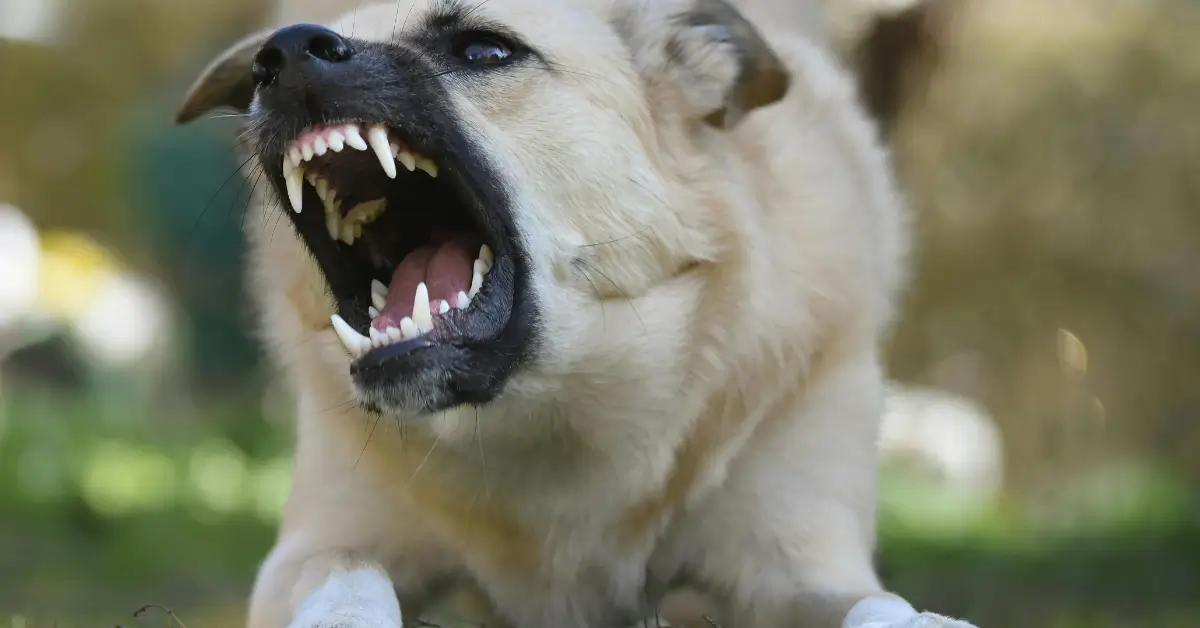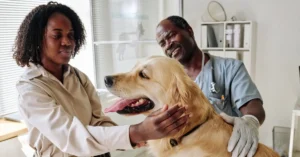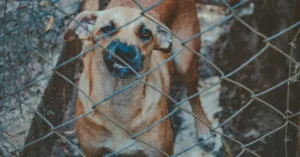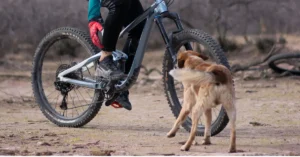If you’ve ever wondered, “Why does my dog get aggressive when I discipline him?” you’re not alone. Many dog owners encounter difficulties when attempting to modify their pets’ behaviors. This guide is designed to help you understand why aggression occurs during discipline and how to address it effectively, ensuring safety and promoting a positive relationship with your dog.
Aggressive reactions to discipline can be frightening and dangerous. It’s important to understand that this behavior doesn’t mean your dog is inherently bad or beyond help. Instead, it suggests that your current approach might need adjustment and that understanding the underlying causes of aggression is key.
This article will discuss various methods for soothing your dog and ensuring that your disciplinary actions lead to constructive outcomes rather than negative reactions. By applying the right techniques, you can transform challenging moments into opportunities for bonding and learning, making discipline a positive experience for you and your dog.
Decoding Aggression in Dogs
Dog aggression arises from various sources like fear, the need to guard food or toys, or pain. It’s essential to identify the specific aggression type your dog exhibits—whether it’s reactive towards strangers, possessive over resources, or defensive against other dogs—to effectively address the issue. Understanding your dog’s behavior, from body language cues like growling or trying to bite to its reactions in different situations, helps tailor the right behavior modification strategies. This approach will guide appropriate interventions, avoid worsening the situation, and support a more disciplined and calm interaction with your dog.
Identifying Different Types of Aggression
Aggression in dogs can take various forms, each influenced by different motivations and necessitating distinct management techniques. Territorial aggression involves dogs defending their space, often against perceived intruders. Fear aggression is sparked by anxiety or perceived threats, leading to defensive actions. Protective aggression occurs when a dog must defend its owners or itself. Recognizing these patterns is crucial for effective behavior modification. It allows dog owners to specifically tailor training and intervention methods, addressing the underlying problems and ensuring the safety of both the dog and others.
This understanding helps mitigate aggressive responses and prevents the escalation of unwanted behavior. By observing the dog’s body language and reactions, owners can discern whether the aggression is situational or a more deeply rooted behavioral issue, guiding the approach to rehabilitation and companionship.
Early Signs of Aggressive Behavior
Recognizing the early signs of aggression can be pivotal in preventing serious incidents. These signs often include growling, snarling, snapping, and exposing teeth. Such behaviors are not just displays of displeasure; they are clear indicators that a dog feels threatened or stressed and may escalate to biting if not properly managed. Early intervention based on these signs can defuse potentially dangerous situations and help guide your approach to modifying your dog’s behavior. Understanding these signals as part of the broader context of your dog’s body language can inform the steps needed to create a calmer, safer environment for everyone.
By expanding our understanding of different types of aggression and recognizing early warning signs, we can better manage and modify aggressive dog behavior. This proactive method not only improves the safety and welfare of pets and their human companions but also fosters a more peaceful home atmosphere.
Common Discipline Mistakes Owners Make
It’s crucial to recognize that how we discipline our dogs can significantly affect their behavior. Ineffective methods not only fail to stop unwanted behaviors but can exacerbate aggression. By understanding the common pitfalls in dog discipline, owners can refine their approach and foster a more positive relationship with their pets.
The Impact of Harsh Discipline and Punishments
Physical punishment might appear as a shortcut to halt undesired behavior, but it can have long-lasting negative effects. When dogs are punished harshly, they might learn to associate discipline with fear and pain, leading them to react with aggression as a defense mechanism. Research indicates that dogs subjected to frequent physical punishment may develop deep-seated anxieties and display increased aggression towards familiar people and strangers. This can manifest in growling, snapping, or biting when they feel threatened or cornered.
Harsh discipline can also disrupt dogs’ daily routines, making them feel insecure and more likely to bite out of intimidation or fear. Understanding that a dog’s aggressive reaction is often a form of communication expressing discomfort or anxiety is crucial. Instead of resorting to physical punishment, which may exacerbate behavioral problems and damage your dog’s trust, consider positive training sessions that reinforce good behavior and gradually reduce unwanted responses. Consistently supervising and guiding your dog calmly and controlled helps build their confidence and ensures they respond positively in stressful situations.
The Problem with Inconsistent Dog Training Guidelines
Consistency is key in dog training. When rules and discipline methods fluctuate, it can confuse dogs and make it hard for them to understand what is expected of them. This inconsistency can inadvertently reinforce bad behavior or trigger aggressive responses due to frustration and confusion. To effectively train your dog and minimize aggressive behavior, it’s important to establish clear, consistent guidelines and stick to them. This means applying the same rules and consequences for specific behaviors every time, which helps your dog learn appropriate behaviors more quickly and reduces anxiety-related aggression.
By addressing these common discipline mistakes, owners can create a more stable and understanding environment for their dogs, which not only reduces the likelihood of aggression but also enhances the bond between pet and owner. Consistently applying the most effective and humane discipline strategies is essential for nurturing a well-behaved and happy canine companion.
Proven Methods to Correct Aggressive Responses
Effective strategies for managing a dog’s aggressive behavior can lead to significant improvements. Understanding and implementing these methods correctly can help reduce or even eliminate aggression, making interactions safer and more enjoyable for both the dog and its owner.
Embracing Positive Reinforcement Techniques
Positive reinforcement is an effective resource in modifying a dog’s behavior. Instead of punishing bad behavior, rewarding good behavior with treats, praise, or play can encourage your dog to repeat those actions. This method builds a positive association with good behaviors, making them more likely to recur. For example, if a dog sits calmly when guests arrive instead of growling, giving it a treat immediately reinforces that calm behavior is preferable. Over time, these positive experiences can reshape your dog’s reactions and significantly reduce aggressive tendencies.
Benefits of Professional Training and Behavioral Adjustments
In cases where aggression is deeply ingrained or particularly severe, the expertise of a professional dog trainer or animal behaviorist can be invaluable. These professionals are trained to assess the causes of your dog’s aggressive behavior and develop a tailored plan that addresses these specific issues. They can introduce techniques and training routines that might be difficult for a typical owner to implement on their own, such as controlled exposure to triggers in a safe environment, which can gradually desensitize the dog. Working with a professional not only helps manage the aggression effectively but also ensures the safety and well-being of both the dog and its human companions.
Building Foundations: Socialization to Prevent Aggression
Laying a proper foundation through early socialization is crucial for preventing many behavioral issues, including aggression. Dogs that are well-socialized from a young age are typically more confident and less fearful in various situations, which can significantly decrease their likelihood of responding aggressively.
Why Early Socialization Matters
Early socialization involves exposing your puppy to various people, animals, and environments during its critical learning phase—typically before it turns 16 weeks old. This exposure helps them learn to cope with new experiences and reduces their tendencies to fear or aggression towards unfamiliar situations. Regular, positive interactions within these formative weeks can help prevent fear-based aggression and other related behavioral issues from developing.
Effective Socialization Strategies
To effectively socialize a puppy, gradually introduce it to different situations under controlled conditions. Start with less crowded environments and slowly increase the complexity of their experiences. Use a leash to manage interactions and ensure safety. Regular visits to dog parks, pet-friendly stores, and outdoor events can be part of the socialization process. Additionally, enrolling your puppy in a kindergarten class can provide structured exposure to other dogs and people, all under the guidance of professional trainers. This not only helps in reducing potential aggressive responses but also aids in building a well-rounded, sociable pet.
These strategies, rooted in understanding canine behavior and psychology, are designed to effectively address and modify aggressive behavior. By using positive reinforcement and ensuring comprehensive socialization, dog owners can foster a more peaceful and respectful relationship with their pets.
Fostering a Nurturing Environment for Your Dog
Creating a nurturing environment is fundamental to effectively managing and reducing aggressive dog behavior. This approach focuses on understanding and modifying the conditions that contribute to stress and anxiety in your pet, which can trigger aggressive reactions.
Establishing Routine and Consistency
Stability in a dog’s daily life can significantly alleviate anxiety, which is a common trigger for aggressive outbreaks. Establishing a consistent routine for feeding, exercise, and sleep helps create a sense of security and predictability for your dog. This regularity can calm your pet, making them less likely to react aggressively. Consistent disciplinary rules and commands also play a crucial role; they teach your dog what is expected and allow them to feel confident in their actions, reducing stress and confusion.
Techniques for Minimizing Stress
Minimizing your dog’s stress involves creating a comfortable living space and providing regular physical and mental activities. Ensure your dog has a quiet space to retreat, free from overwhelming noise and chaos. Regular exercise helps burn off extra energy that could otherwise feed into anxiety and aggression. Additionally, engaging your dog with interactive toys and puzzle feeders can provide essential mental stimulation, keeping their minds sharp and focused and diverting their attention from anxiety-related behaviors.
Determining When to Consult Dog Training Experts
Understanding when to seek outside help from training experts can make a considerable difference in managing your dog’s aggressive behavior, particularly when initial efforts aren’t working.
Signs That It’s Time for Professional Intervention
If your dog’s aggression persists despite consistent home training and environment adjustments, or if it becomes more severe, consulting a veterinary behaviorist may be necessary. Key indicators that professional help is needed include your dog snapping, biting, or growling aggressively in situations that typically wouldn’t provoke such behavior. These responses can signify deeper issues such as anxiety, dominance struggles, or pain and might lead to severe outcomes like puncture wounds if not addressed.
Early detection of these signs is essential to rehabilitate your dog and prevent further complications effectively, emphasizing the need for medical attention rather than punishment to manage their temperament and underlying anxieties.
How to Collaborate with Dog Behavior Specialists
Collaborating with dog behavior specialists, such as certified behaviorists or professional trainers, involves more than just attending sessions. It means actively participating and consistently reinforcing the techniques taught during training at home. These specialists can provide customized training strategies targeting your dog’s specific issues, including desensitization exercises to reduce fear or aggression triggers.
By closely collaborating with these professionals, you can learn how to better communicate with your dog, understand their needs, and apply effective interventions to ensure long-term behavioral improvements.
By building a supportive environment and knowing when to seek professional advice, you can help your dog overcome aggressive tendencies and foster a safe and harmonious living situation.
Wrapping Up: Building Harmony Through Understanding and Discipline
Navigating the challenges of disciplining a dog that shows aggression requires patience, understanding, and the right strategies. By recognizing the signs of aggression early and understanding its roots—whether they stem from fear, confusion, or past experiences—you can implement methods that truly address and correct these behaviors.
It’s crucial to avoid the pitfalls of harsh punishment and inconsistent rules which can exacerbate aggression rather than curb it. Instead, fostering a positive environment through consistent routines, stress reduction techniques, and positive reinforcement can lead to significant improvements. This not only helps in calming your dog but also enhances your bond and ensures that discipline improves your dog’s behavior without causing further issues.
For those cases where progress seems slow or stagnant, don’t hesitate to seek help from professionals. Dog behavior specialists have the expertise to offer tailored solutions that are effective and humane, ensuring the well-being of both you and your canine companion.
By committing to these approaches, you can help your dog overcome aggressive tendencies and enjoy a more peaceful, respectful coexistence. This commitment to understanding and properly managing canine behavior paves the way for a happier, safer home for everyone.
Frequently Asked Question
Q: How can I stop aggression when disciplining my dog?
A: You can stop aggression in dogs by using positive reinforcement training methods instead of punishment. Punishing a dog may lead to more aggressive behavior and does not address the underlying issue.
Q: What should I do if my dog starts to growl during discipline?
A: If your dog is growling, it’s a sign of discomfort or fear. Stop what you’re doing, give your dog space, and try to understand why they are reacting this way. Seek help from a veterinary behaviorist if needed.
Q: Is it mean to punish a dog for bad behavior?
A: Punishing a dog may cause fear and anxiety, leading to more behavioral problems in the future. Using positive reinforcement techniques is crucial for promoting good behavior instead of punishment.
Q: How can I address aggressive behavior in dogs without making the dog more aggressive?
A: Address the issue by identifying triggers, employing behavior adjustment methods, and consulting with professionals if necessary. Punishing a dog for aggression is not effective and may worsen the behavior.
Q: What should I do if my dog tries to bite me or another dog?
A: If your dog is showing aggressive behavior, such as trying to bite, it’s crucial to seek assistance from a professional trainer or behaviorist. Avoid punishing the dog and focus on positive reinforcement training.
Q: Can a rescue dog with a history of aggression be rehabilitated?
A: Yes, with the right training and support, rescue dogs with aggression issues can be rehabilitated. Seek help from professionals who specialize in dog behavior modification.
Q: How can I prevent food aggression in dogs?
A: To prevent food aggression in dogs, work on desensitizing your dog to the presence of food or toys, avoid punishing them around their food bowl, and use positive reinforcement to create positive associations with meal times.



